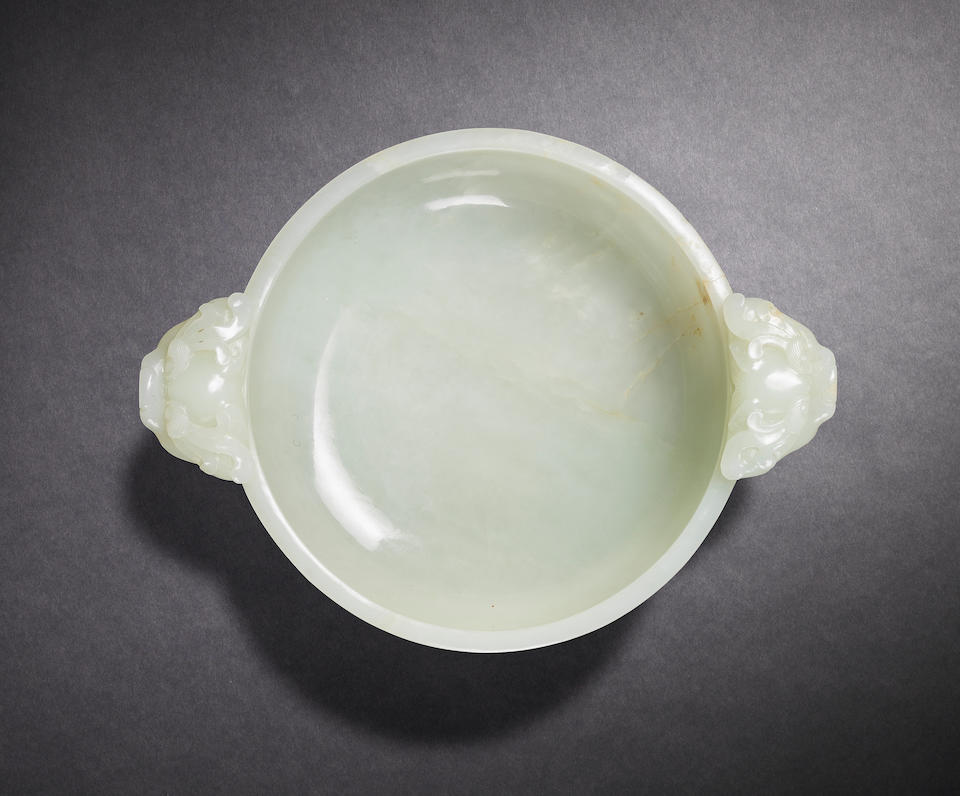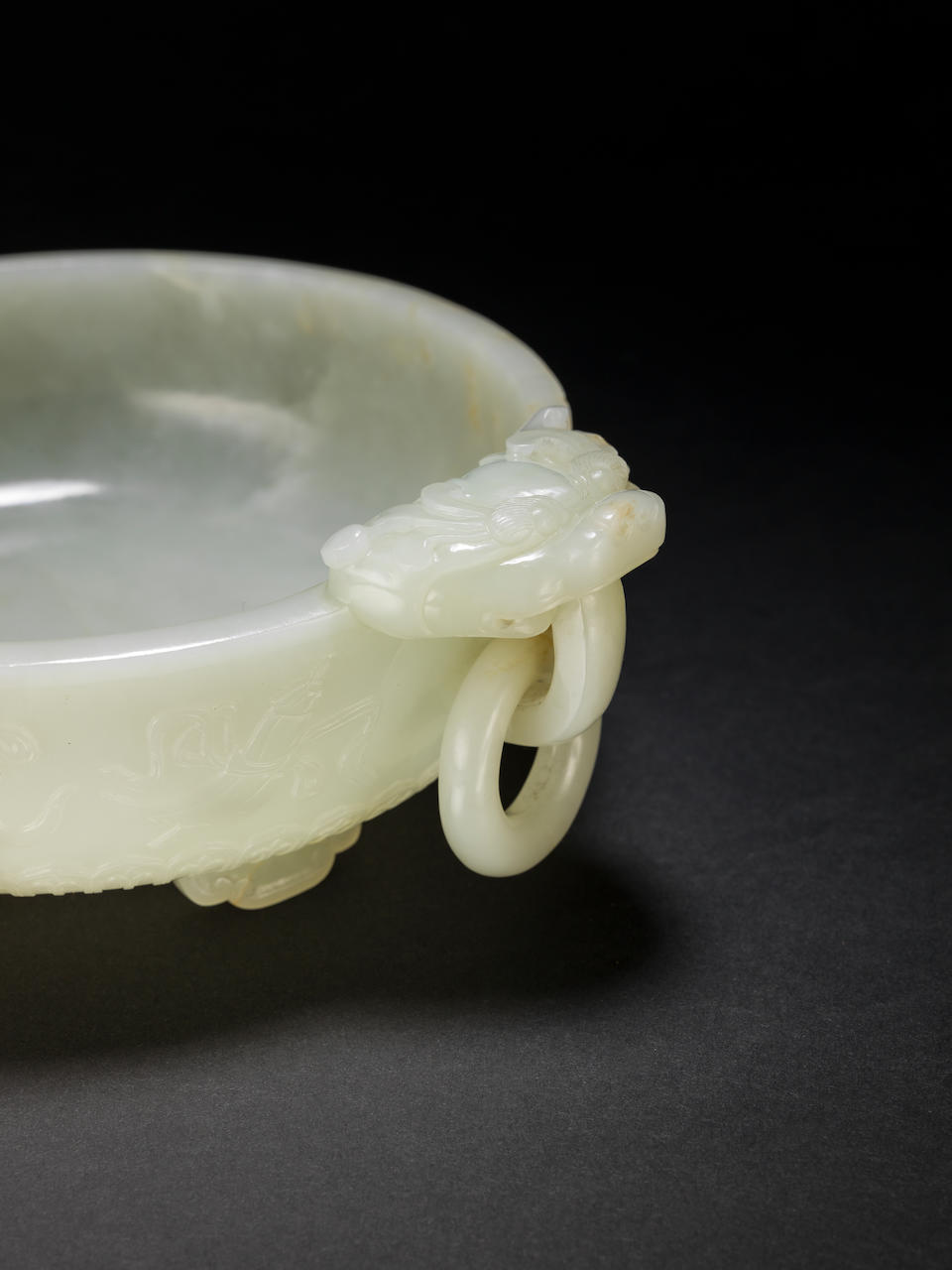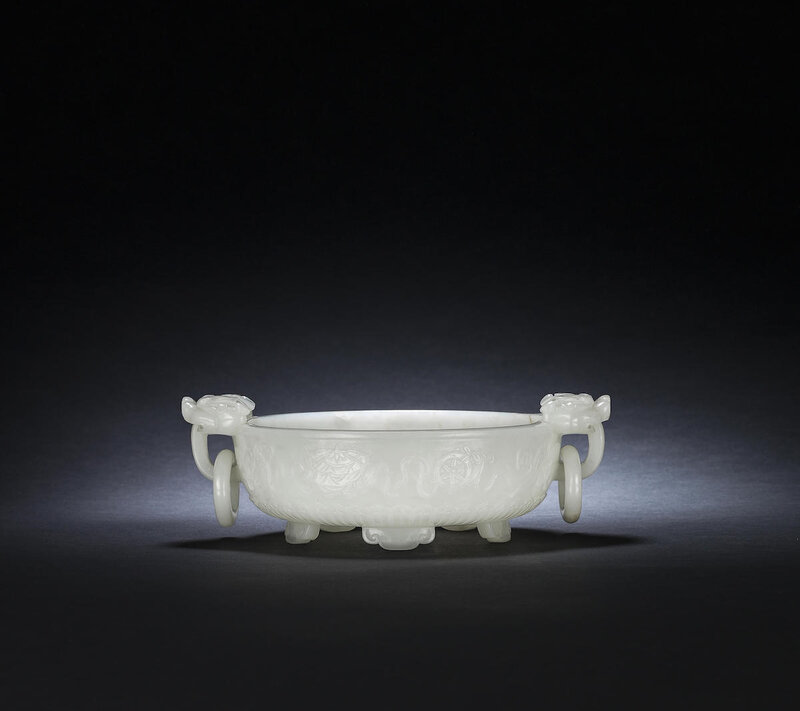A fine and rare white jade 'Bajixiang' 'marriage' bowl, Qianlong period (1736-1795)


Lot 56. A fine and rare white jade 'Bajixiang' 'marriage' bowl, Qianlong period (1736-1795); 21.5cm (8 1/2in) wide. Estimate HK$ 600,000-800,000. Sold for HK$ 937,500 (€ 111,469). Photo: Bonhams.
The rounded sides finely carved in relief with evenly-spaced beribboned Eight Buddhist Emblems, bajixiang, above a lappet border, each enclosing a trefoil motif, the lipped rim flanked by a pair of high relief carved mythical beast handles, each suspending a loose ring, all elevated on five splayed ruyi feet, the stone of an even white tone with faint russet veins, wood stand.
Provenance: Acquired prior to 27 November 1946 (date of valuation by Camerons Ltd., London), and thence by descent.
Note: The present bowl demonstrates the highly skilled craftsmanship achieved at the height of the Qing dynasty, during the celebrated Qianlong reign. This is exemplified in the remarkable carving of the mythical beast loose ring handles, the evenly spaced Eight Buddhist Emblems on the exterior, finely balancing the symbolic embellishment of the exterior yet successfully allowing the fine quality of the white jade to show at the same time.
It is likely that the present bowl was carved after the Qianlong emperor's campaign for the pacification of the Dzungars and Xinjiang (1755-1759), as this campaign secured control over the area of Khotan, allowing direct access to greater quantities of larger-sized high quality jade and therefore for the production of generously proportioned carvings and vessels such as the present lot compared to previous periods. For related jade 'marriage' bowls from the Qing Court Collection, see Zhen Xinmiao, Compendium of Collections in the Palace Museum: Jade, Qing Dynasty, vol.10, Beijing, 2010, pls.180, 198 and 205. The sheer opulence of the present bowl is emphasised by the generous proportions of the well-hollowed interior, and the significant wastage of the prized jade stone in the carving of the flanking mythical beast loose ring handles, thus creating a spacial depth of form. The five ruyi-shaped supports also raise the bowl, allowing a greater appreciation of the well carved lappet border and finely balanced suspended rings.
This magnificent jade bowl belongs to the group of 'marriage' bowls alternatively carved with butterfly, bat or dragon handles, popular in the Qing Court. Just as with butterfly-handled bowls, the two mythical beasts also represent the concept of happiness at union. This combined with the auspicious Eight Buddhist Emblems: Pair of Fish, Victory Banner, Wheel of Dharma, Parasol, Lotus, Endless Knot, Treasure Vase and Conch Shell, would have been a particularly fitting present on the event of a wedding celebration.
Compare a white jade 'marriage' bowl carved with similar mythical beast-head handles, in the De An Tang collection, included in the Palace Museum exhibition A Romance with Jade, Beijing, 2004, Catalogue no.7. See also a related pale green jade 'marriage' bowl, 18th century, but carved on the exterior with leafy blossom sprays and lingzhi and on the interior with lingzhi, sold at our London rooms, 17 May 2012, lot 40.
Bonhams. Fine Chinese Ceramics and Works of Art, Hong Kong, 4 June 2015

/https%3A%2F%2Fprofilepics.canalblog.com%2Fprofilepics%2F1%2F0%2F100183.jpg)
/https%3A%2F%2Fstorage.canalblog.com%2F03%2F02%2F119589%2F96711876_o.jpg)
/https%3A%2F%2Fstorage.canalblog.com%2F11%2F31%2F119589%2F94773502_o.jpg)
/https%3A%2F%2Fstorage.canalblog.com%2F20%2F83%2F119589%2F94772815_o.jpg)
/https%3A%2F%2Fstorage.canalblog.com%2F26%2F72%2F119589%2F75604929_o.jpg)
/https%3A%2F%2Fstorage.canalblog.com%2F59%2F60%2F119589%2F26458628_o.jpg)



/image%2F1371349%2F20240406%2Fob_a54acc_435229368-1644755382961141-18285727260.jpg)
/image%2F1371349%2F20240229%2Fob_b1ea4c_429582962-1625285201574826-43586635599.jpg)
/image%2F1371349%2F20240229%2Fob_84bc3b_429558450-1624783464958333-37673404077.jpg)
/http%3A%2F%2Fstorage.canalblog.com%2F36%2F88%2F119589%2F129555285_o.jpg)